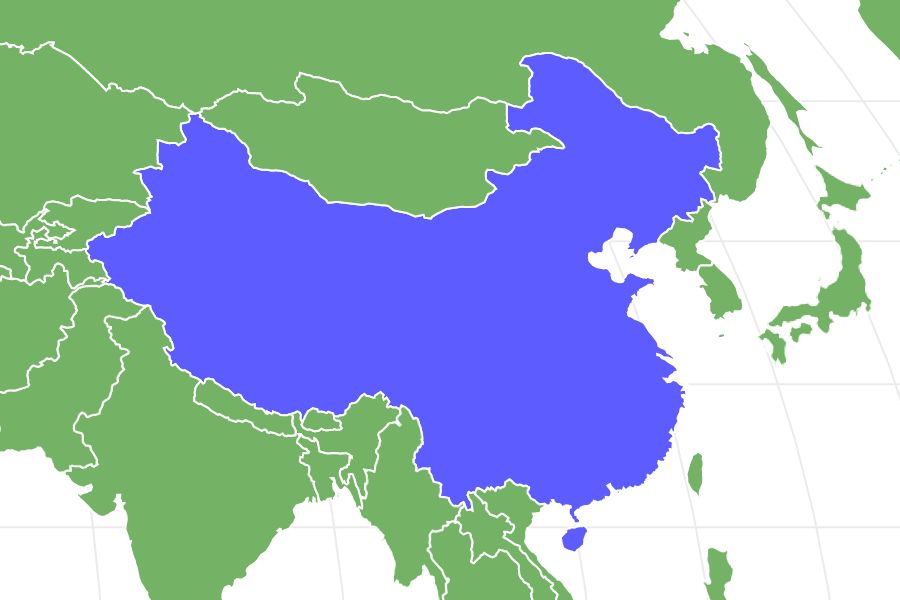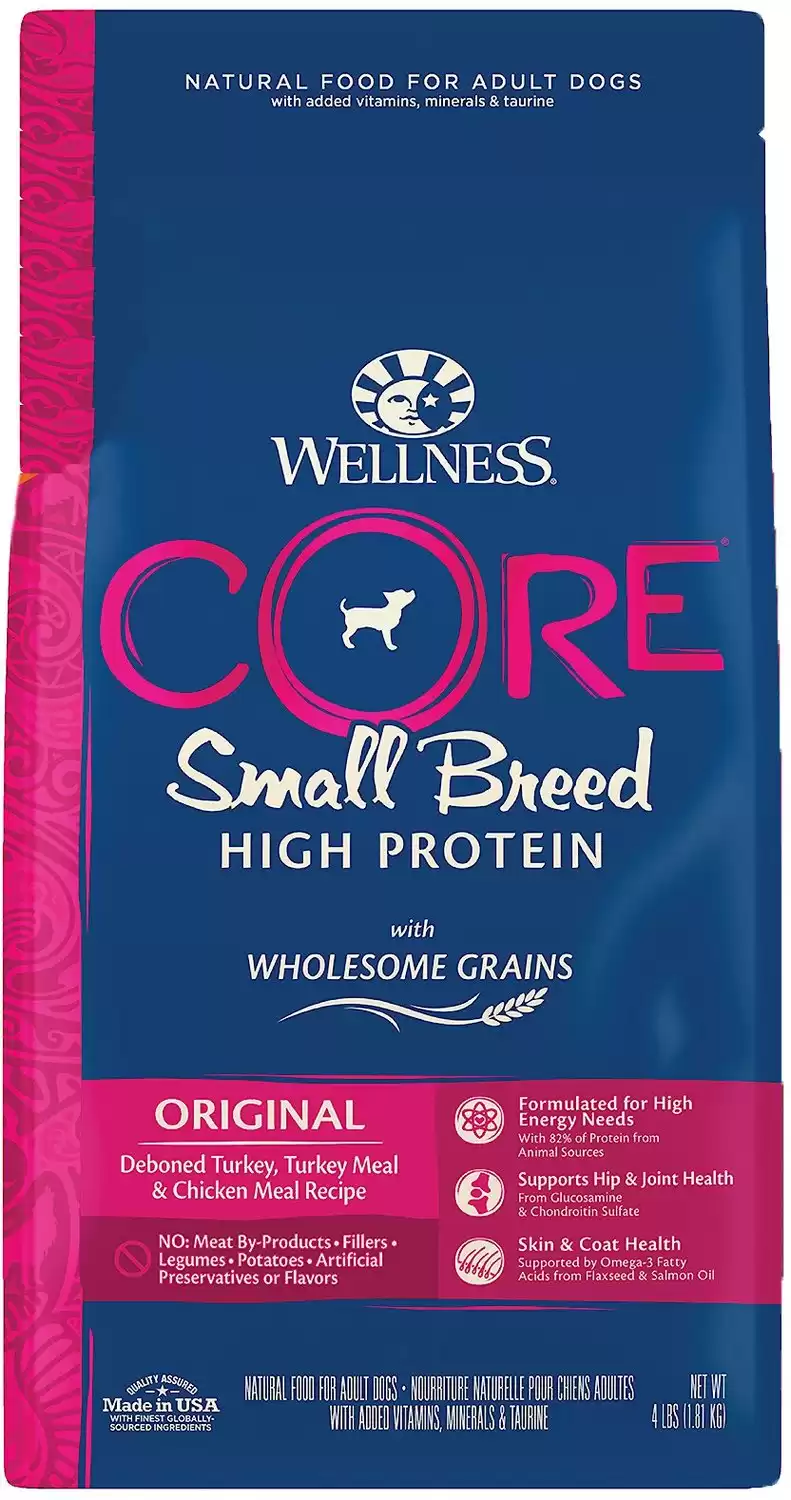Chinese Crested Dog
Canis lupus
A hairless breed of dog!
Advertisement
Chinese Crested Dog Scientific Classification
- Kingdom
- Animalia
- Phylum
- Chordata
- Class
- Mammalia
- Order
- Carnivora
- Family
- Canidae
- Genus
- Canis
- Scientific Name
- Canis lupus
Read our Complete Guide to Classification of Animals.
Chinese Crested Dog Conservation Status
Chinese Crested Dog Facts
Chinese Crested Dog as a Pet:
- General Health
- Energy Level
- Shedability
- Trainability
- Intelligence
- Tendency to Chew
- Size
- Family and kid friendliness
- Yappiness / Barking
- Moderate
- Hypoallergenic
- Yes
- Separation Anxiety
- High
- Preferred Temperature
- Warm climate
- Exercise Needs
- Low
- Friendly With Other Dogs
- High
- Pure bred cost to own
- $1,000
- Dog group
- Toy
- Male weight
- 5-12 lbs
- Female weight
- 5-12 lbs
This post may contain affiliate links to our partners like Chewy, Amazon, and others. Purchasing through these helps us further the A-Z Animals mission to educate about the world's species.
View all of the Chinese Crested Dog images!
The Chinese crested dog is a small toy breed with an unusual hairless appearance.
Except for a flowing mane and the big, fluffy ears, this breed has smooth, hairless skin with a fleshy or dark color. It is believed that this breed was originally brought to China from Africa and then adapted to fit the preferences of its breeders.
See all of our expert product reviews.
Besides their obvious utility as loyal pets, they also served a role as rat catchers aboard Chinese ships, where they were introduced to the rest of the world on voyages. They gained popularity in the United States during the late 19th century. Although not common or widespread, this breed is a treasured companion for many owners.
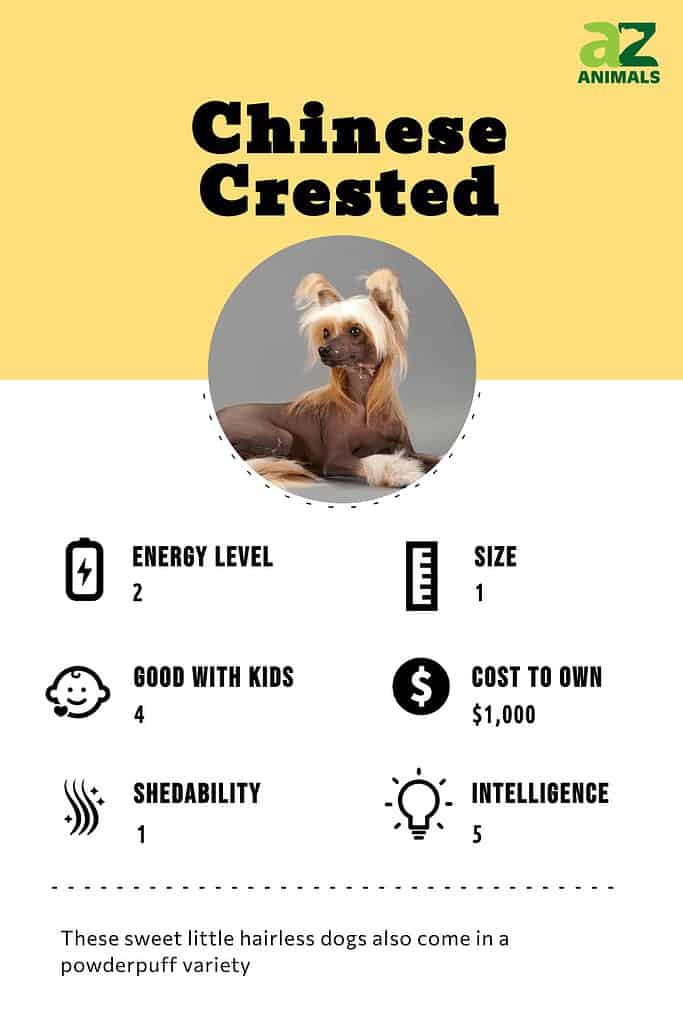
Evolution
The Chinese Crested dog is believed to have evolved from African Hairless dogs, which were bred to be small lap dogs by Chinese breeders to resemble the popular Shi Tzu and Pekingese. Chinese sailors traveled the seas with the little dogs – who were traded at ports all over the world. The dogs served as rat catchers during their time at sea. British, French and Portuguese explorers also picked up the dogs from Chinese ports during the 1700s and 1800s. By the 1900s, the Chinese Crested began to appear in European paintings.
In the 1950s, the famous American entertainer, Gypsy Rose Lee, was gifted a Chinese Crested by her sister. The singer became an ardent breeder and is credited with publicizing the Chinese Crested worldwide. Some of the most active kennels in the world trace the ancestry of their dogs to lines of dogs bred by Gypsy Rose Lee.
Types of Chinese Crested
There are two types of Chinese crested dog: the powderpuff and hairless. As the names imply, the powderpuff has a long, soft coat of fur, while the hairless only has hair around the face, ears, tail, and feet. To clear up a point of confusion, the hairless and powderpuff versions are not separate Chinese dog breeds.
The hairless trait is actually caused by an incomplete dominant gene, which means the offspring only needs to inherit the trait from a single parent to also express it. The powderpuff trait needs to be inherited by both parents simultaneously. For this reason, it’s possible for both hairless and powderpuff variations to appear in the same litter of two purebred parents. The two variations are otherwise the same, so it simply comes down to a matter of preference with the hair.
Health and Entertainment for your Chinese Crested Dog
See all of our expert product reviews.
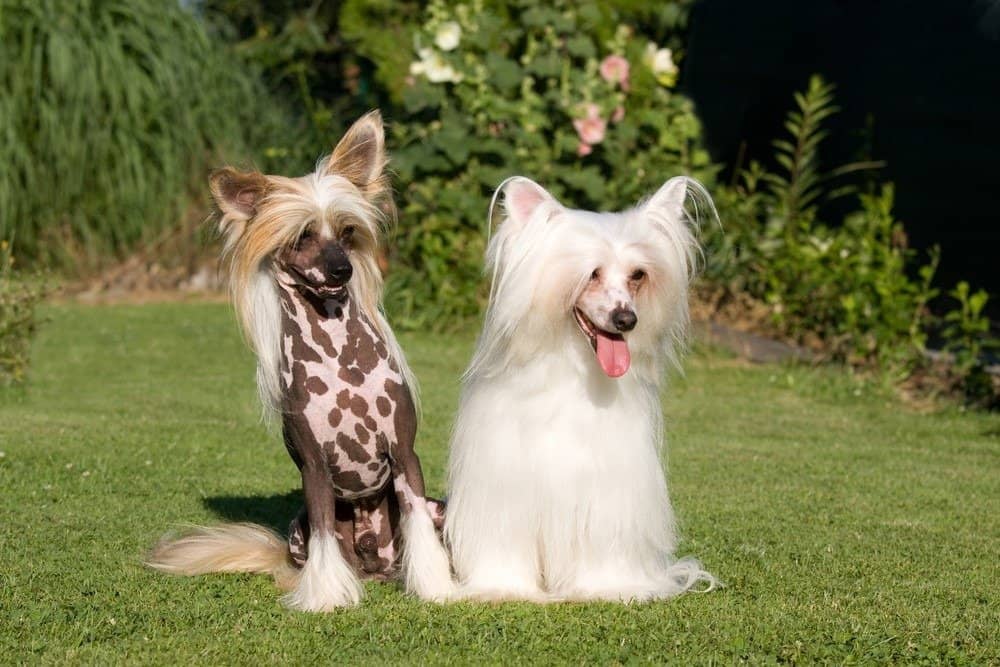
There are two types of Chinese crested dog: the powderpuff and hairless.
©Lenkadan/Shutterstock.com
Owning a Chinese Crested Dog: 3 Pros and Cons!
| Pros! | Cons! |
|---|---|
| Friendly and loyal This breed wants nothing more than to please its owner and stay out of trouble. | Somewhat fragile Because of its small size and exposed skin, this breed may not tolerate a lot of rough play or outdoor exposure. |
| Easy to train This breed is attentive to its owner’s commands. | Gains weight easily This breed should be kept away from fattening foods. |
| Minimal shedding The hairless breed requires very little grooming and cleanup. It is a good hypoallergenic pet. | Built for shorter spurts of activity If you want a dog that’s constantly active, then this breed may have some shortcomings. |
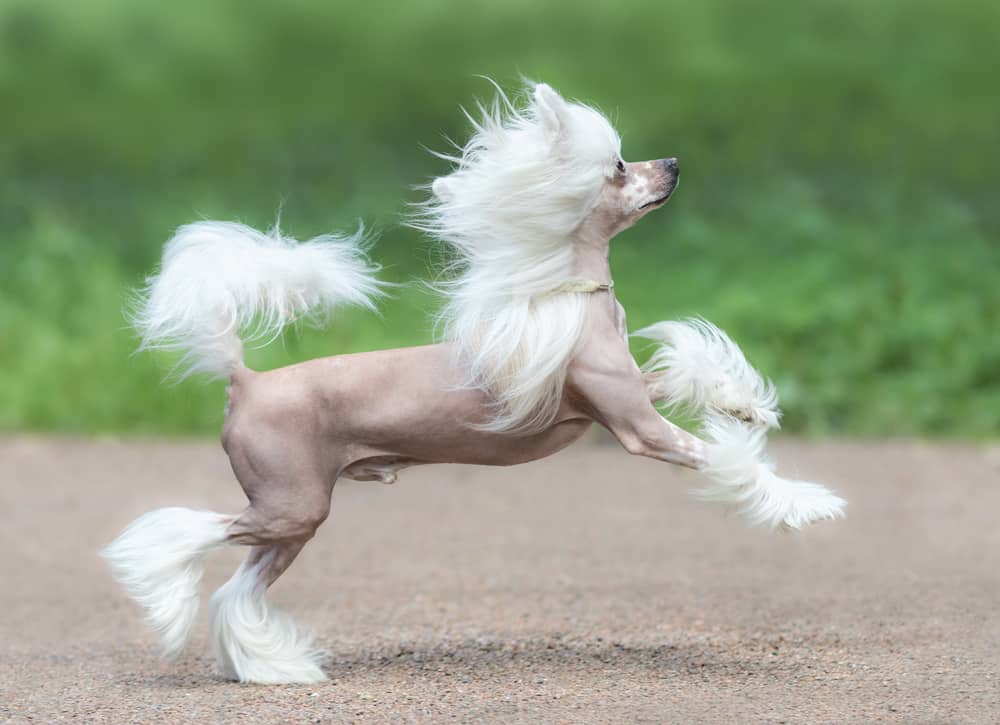
Chinese cresteds are small and fragile – weighing up to 12 pounds.
©Abramova Kseniya/Shutterstock.com
Size and Weight
This breed is notable for its small size. Males and females vary by a small amount.
| Height (Male) | 9 to 13 inches |
|---|---|
| Height (Female) | 9 to 11 inches |
| Weight (Male) | 5 to 12 pounds |
| Weight (Female) | 5 to 12 pounds |
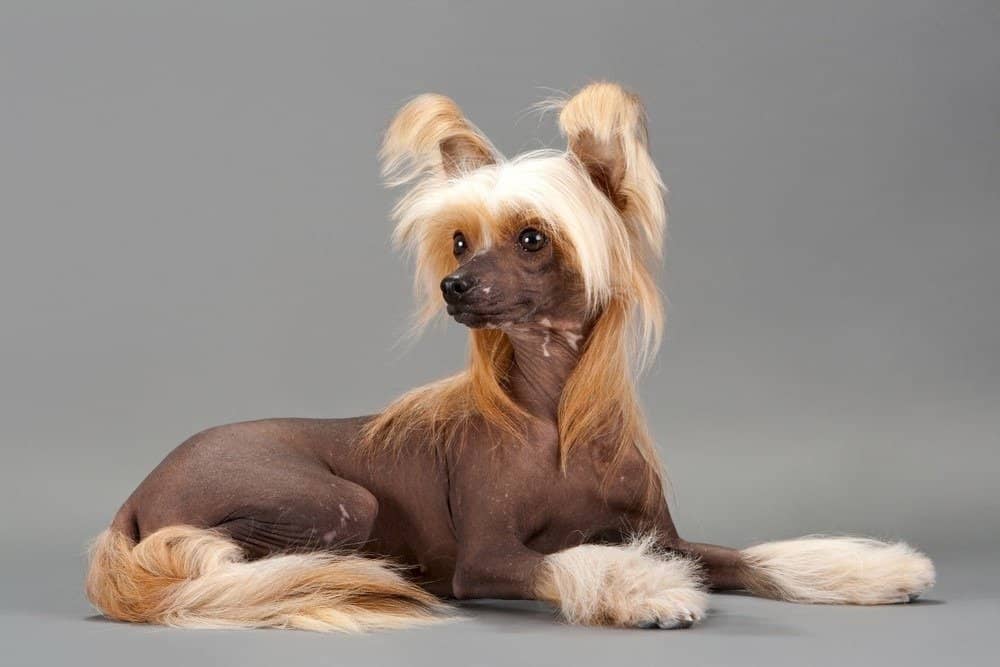
Aside from sensitive skin issues, the Chinese Crested is a fairly healthy breed.
©Medvedev Andrey/Shutterstock.com
Common Health Issues
The Chinese crested dog is a fairly healthy breed with only a few significant health problems. Among the most common, it is prone to several eye diseases, including retinal atrophy (a degenerative condition), lens luxation (in which the lens becomes detached from the rest of the eye), and glaucoma (damaged optical nerves).
Other potential problems include cancer, autoimmune disorders, and patellar luxation, a genetic condition in which the kneecaps can pop out of place, causing lameness and gait difficulties. These Chinese dog breeds may be allergic to certain fabrics or materials that could cause rashes or irritation of the skin. It is a good idea to ask a breeder if they’ve screened for any genetic diseases before making your purchase. To sum up the breed’s most common health issues:
- Eye Diseases
- Allergic Reactions or Skin Problems
- Cancer
- Patellar luxation (also known as trick knee)
Temperament and Behavior
The Chinese crested dog is a gentle, good-natured, and affectionate breed that will bond deeply with its owner. No matter your living situation, the dog’s intelligent and adaptable personality makes it very alert and attentive to its owner and surroundings. This is a very versatile breed, ideal for training and teaching tricks.
However, due to the dog’s rather sensitive nature, you should not be harsh or overbearing with it. A tender and patient attitude is most likely to yield results. As long as you are attentive to the dog’s personal desire for companionship, you should have few problems.
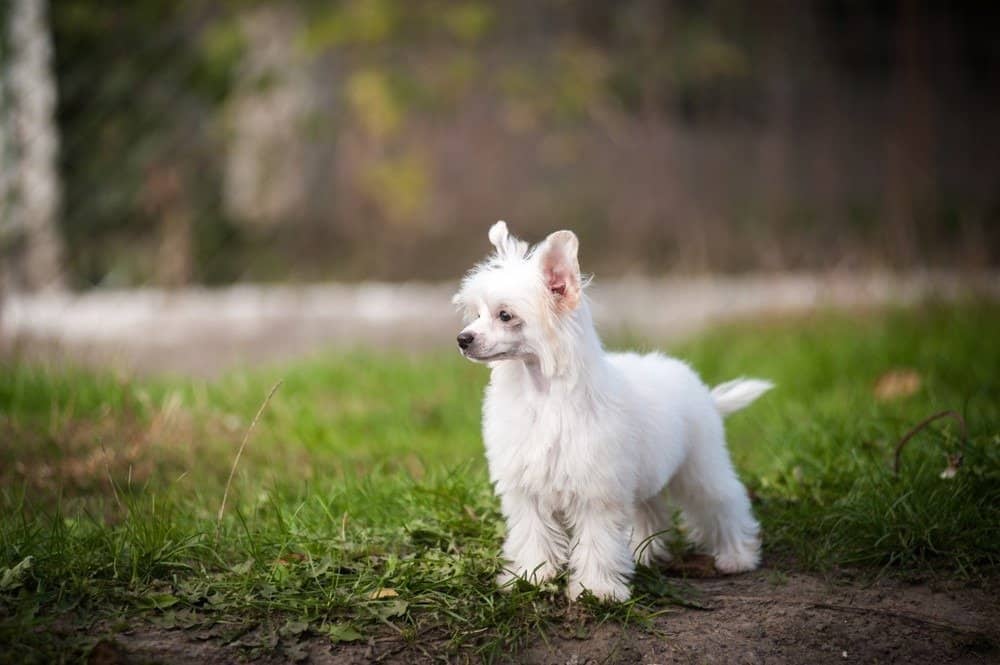
The Chinese Crested dog is a gentle, affectionate breed that will bond easily with its family.
©David Raihelgauz/Shutterstock.com
How to Take Care of a Chinese Crested Dog
Pet owners should be aware of the time and effort required to take care of this breed. Although not quite as high maintenance as some dog breeds, the Chinese crested dog does have its own unique challenges, including its sensitive skin. It is a good idea to have your puppy screened by the breeder or later at the vet for early signs of health problems.
The Best Dog Food for Chinese Crested Dogs
The Chinese crested dog should be fed a high-quality diet to supports a moderately active lifestyle. It is also a good idea to hand out occasional treats to encourage its training. However, you should carefully monitor its calorie intake, because this breed is prone to weight gain.
If it seems like your dog is gaining weight, then you should think about cutting back on calories or purchasing leaner food to compensate. You should avoid cooked bones and high-fat foods altogether. Table scraps and human food should not be given on a regular basis.
Since these dogs can experience allergies, look into some limited ingredient and allergy-control dog food options.
A-Z Animals choosesWellness CORE Small Breed Dry Dog Food with Wholesome Grains, High Protein Dog Food as the best dog food for Chinese Crested Dogs.
This filler-free chicken and turkey food has natural glucosamine and chondroitin for the joints, plus calcium and phosphorus for extra protection and bone strength. Additionally, carrots and taurine both lend themselves to clear, sharp eyes.
Think about adding Wellness CORE Small Breed Wholesome Grains High Protein dog food to your amazon cart.
- Chicken and turkey meal, deboned chicken recipe for small dog breeds
- Levels of taurine for heart health
- Promotes lean muscles and lean body mass
- No legumes, potatoes, fillers, artificial colors or flavors
Maintenance and Grooming
The Chinese crested dog has its own particular grooming challenges. Obviously, the hairless variety requires comparatively little grooming and maintenance, but because the skin is so sensitive, it is a good idea to apply lotion as needed to stop or prevent dry or chafing skin. You should also apply sunscreen whenever you take the dog out in the sun. Because of its minimal shedding, this is a good hypoallergenic dog.

Hairless Chinese Cresteds tend to have sensitive skin that requires lotion and sunscreen.
©Tommy Gildseth / Creative Commons – Original
The powderpuff variation is a little different. It has a longer overcoat and a shorter undercoat, which makes it easier to brush than your typical dog breed, but the coat is also prone to matting. You should brush this dog on a regular basis.
Training
The Chinese crested dog is a very intelligence breed and receptive to training. The ease with which it follows commands and the affection it has for its owner should make training a relative breeze, especially if trained from a younger age.
Because of the dog’s sensitive nature, however, your training should be as gentle and patient as possible. If you raise your voice in anger or make aggressive gestures, then it could backfire by making the dog even less receptive to your commands. It could even strain or break the bonds of loyalty and affection with your dog.
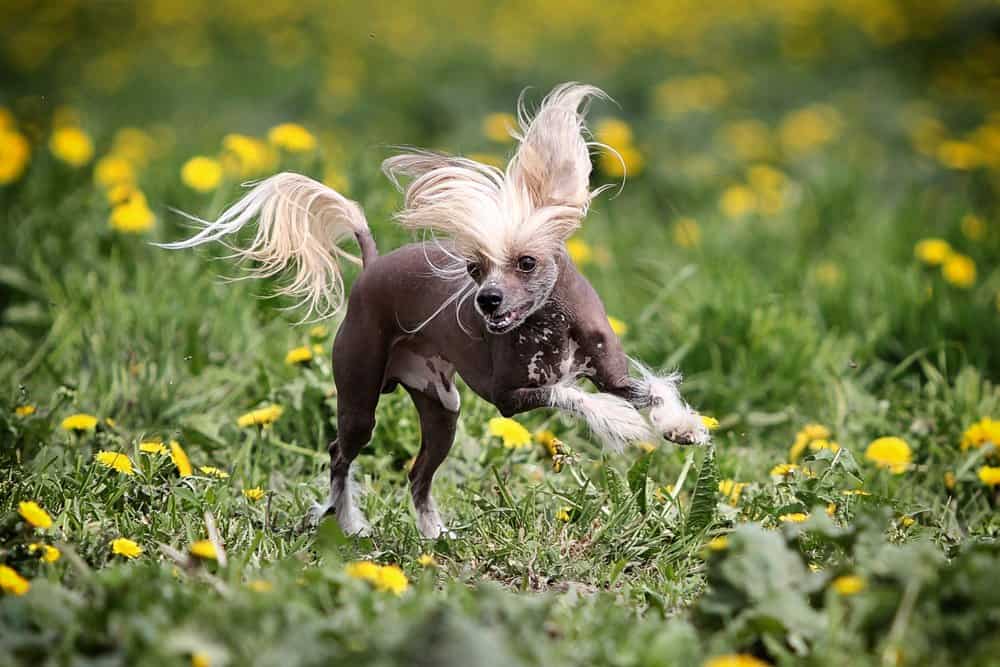
Moderate exercise is enough for the Chinese Crested.
©DragoNika/Shutterstock.com
Exercise
The Chinese crested dog requires only a moderate amount of exercise and play time every day. Short brisk walks should suffice to release some of its excess energy. It’s also a good idea to have toys or balls on hand. When walking outdoors during the warmer months, you should make sure that the dog receives an adequate amount of water and (due to the dog’s exposed skin) some sunscreen. During the colder months, you should strive to keep it adequately warm and protected from the conditions. This breed is athletic enough to take part in some agility and sports competitions for smaller dogs as well.
Puppies
The Chinese crested dog doesn’t have too many extra issue as a puppy, but you should make sure it is up to date on shots and health screening as soon as possible. If you’re interested in the powderpuff dog, then it should become apparently shortly after birth whether the dog will grow hair around its body. This breed is easily integrated into the home if it’s socialized and trained as a puppy.
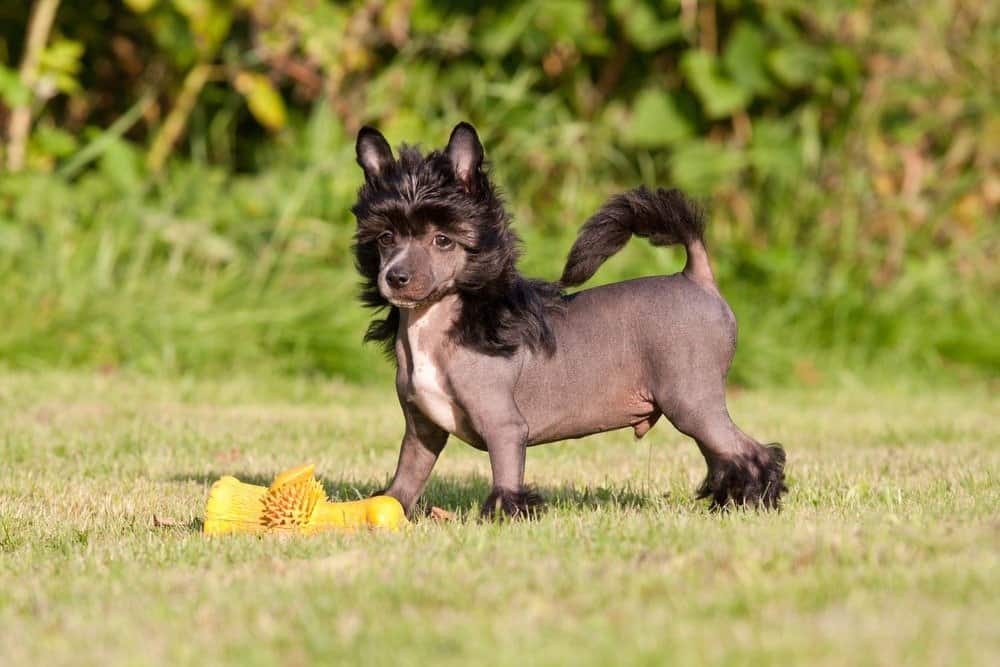
It’s easy to tell if a Chinese crested will be hairless or a powderpuff soon after it is born.
©Lenkadan/Shutterstock.com
Gentle Children and Chinese Cresteds are a Good Match
The Chinese crested dog is considered to be a good family pet that gets along very well with children. It is friendly, loyal, and not easily prone to aggression or anger. However, there is one very important factor to keep in mind. Because of its small stature and exposed skin, this breed may not appreciate too much rough-housing, tugging, or aggressive play. The dog should be introduced gradually to the children and monitored carefully to make sure they are getting along well together. If the dog seems uncomfortable, anxious, or scared, then it is a good idea to intervene immediately.
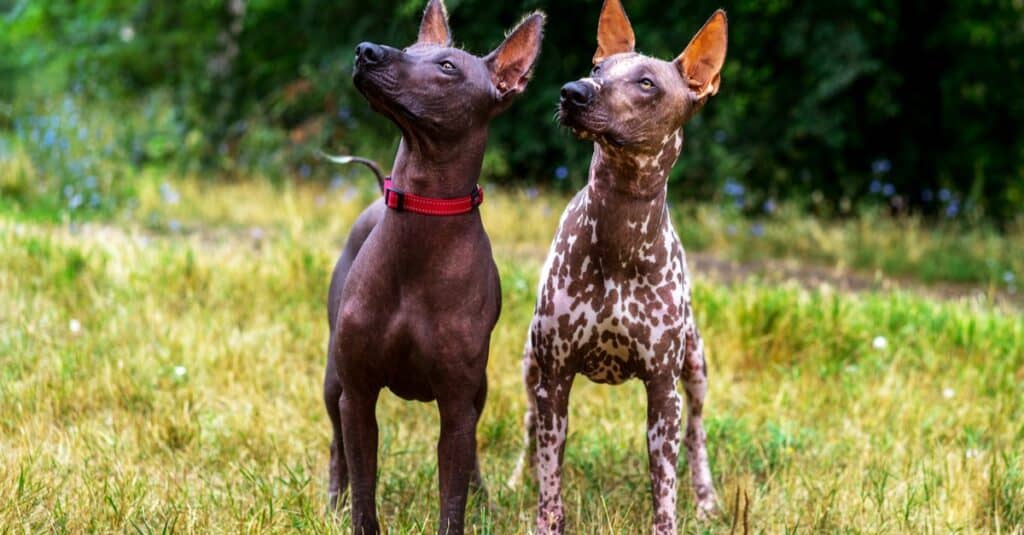
Mexican hairless dogs (Xoloitzcuintle, Xolo) are similar to Chinese Cresteds.
©Masarik/Shutterstock.com
Breeds Similar to the Chinese Crested Dog
If you are a fan of the Chinese crested dog, then you might want to look into these small or hairless breeds:
- Pekingese – The Pekingese is another small toy dog that originated from China. Although the long hair gives it a very different appearance from the Chinese crested dog, this breed nevertheless is affectionate and loyal. It also has a rather independent and confident streak that may get it into trouble.
- Shih Tzu – Like the Pekingese, the Shih Tzu is another long-haired toy dog with a big personality. Originating from Tibet, it is intelligent, alert, and active and traditionally might have been used as a watchdog. This breed also has a stubborn streak in training that expresses itself as a desire for independence.
- Chihuahua – This loyal and intelligent dog is perhaps the smallest recognized breed in the world.
- Xoloitzcuintli – Originating from Mexico, this is a relatively unknown toy breed with very little hair. Once considered sacred by Aztecs, it now makes for a loyal companion and watchdog with an alert temperament.
Popular Names for Chinese Crested Dogs
According to madpaws.com, these are the most popular general dog names:
- Bella
- Charlie
- Max
- Molly
- Coco
- Ruby
- Oscar
- Buddy
Famous Chinese Crested Dogs
Although not among the most popular breeds, the Chinese crested dog has appeared in several notable pieces of fictional cinema.
- This breed was featured in the romantic comedy film How to Lose a Guy in 10 Days, starring Kate Hudson and Matthew McConaughey.
- Peek, a secret agent Chinese crested dog was voiced by the actor Joe Pantoliano in the Cats & Dogs film series.
- Fluffy was Cruella’s personal dog in the 2000 live-action sequel 102 Dalmatians.
Chinese Crested Dog FAQs (Frequently Asked Questions)
What is a Chinese crested dog?
It is a small toy dog with a very distinctive hairless appearance. Few other breeds are quite as unique.
Why do Chinese crested dogs have no hair?
The Chinese crested dog was bred over time for this appearance. This is due to the fact that it has a hairless dominant gene and a hairy recessive gene. If it inherits two recessive genes, then the dog will have a stronger coat of hair. Otherwise, it is mostly hairless. The Chinese crested dog is certainly not an ugly dog. Many owners find their appearance appealing. But amusingly, this breed has won the somewhat unserious World’s Ugliest Dog competition more than any other breed. As the name suggests, the World’s Ugliest Dog selects a winner from among the “ugly dogs” entered by their owners.
How much is a Chinese crested dog worth?
By choosing to adopt a Chinese crested dog, it is possible to purchase one for $300 or less. The cost from a breeder is much more expensive. This could easily run over $1,000.
Are Chinese crested dogs good pets?
The Chinese crested dog has many desirable traits. It is a medium maintenance breed that will remain loyal and affectionate to its owner, and for a smaller dog, it has a good overall temperament. This breed does not quite excel at any feats or particular tasks to the degree of more athletic breeds, so keep that in mind as you make your purchasing decision.
How long does a Chinese crested dog live?
The Chinese crested dog tends to live 12 to 14 years, but in rare cases, it can survive up to 18 years of age.
Are Chinese Crested Dogs herbivores, carnivores, or omnivores?
Chinese Crested Dogs are Omnivores, meaning they eat both plants and other animals.
What Kingdom do Chinese Crested Dogs belong to?
Chinese Crested Dogs belong to the Kingdom Animalia.
What class do Chinese Crested Dogs belong to?
Chinese Crested Dogs belong to the class Mammalia.
What phylum to Chinese Crested Dogs belong to?
Chinese Crested Dogs belong to the phylum Chordata.
What family do Chinese Crested Dogs belong to?
Chinese Crested Dogs belong to the family Canidae.
What order do Chinese Crested Dogs belong to?
Chinese Crested Dogs belong to the order Carnivora.
What genus do Chinese Crested Dogs belong to?
Chinese Crested Dogs belong to the genus Canis.
What type of covering do Chinese Crested Dogs have?
Chinese Crested Dogs are covered in Hair.
What is an interesting fact about Chinese Crested Dogs?
Chinese Crested Dogs are a hairless breed of dog!
What is the scientific name for the Chinese Crested Dog?
The scientific name for the Chinese Crested Dog is Canis lupus.
Thank you for reading! Have some feedback for us? Contact the AZ Animals editorial team.
Sources
- David Burnie, Dorling Kindersley (2011) Animal, The Definitive Visual Guide To The World's Wildlife / Accessed December 1, 2008
- Tom Jackson, Lorenz Books (2007) The World Encyclopedia Of Animals / Accessed December 1, 2008
- David Burnie, Kingfisher (2011) The Kingfisher Animal Encyclopedia / Accessed December 1, 2008
- David Burnie, Dorling Kindersley (2008) Illustrated Encyclopedia Of Animals / Accessed December 1, 2008
- Dorling Kindersley (2006) Dorling Kindersley Encyclopedia Of Animals / Accessed December 1, 2008
- American Kennel Club / Accessed October 29, 2020

